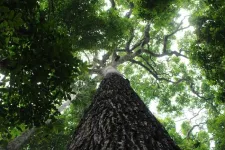(Press-News.org) The significant decline in genetic diversity in the Amazon Basin, following historical events such as European colonisation, deforestation and the extinction of megafauna such as the sloth – the main seed dispersal agents, is of particular concern for the genetic health of Brazil Nut trees (Bertholletia excelsa). As one of the most impacted keystone species in rainforests, Brazil Nut trees are essential for biodiversity and a vital income source for local economies.
A crucial study led by researchers from the Max Planck Institute of Geoanthropology and the Max Planck Institute for Biology Tübingen unveils critical insights into the species' genetic diversity and population dynamics, providing valuable anthropocentric and biological information for this threatened forest ecosystem.
“This research provides an amazing opportunity to study see how human actions, even in the distant past, have affected genetic makeup in a wild species over short time scales,” stated Detlef Weigel, Director of the Department of Molecular Biology at the Max Planck Institute for Biology Tübingen.
Genomic analyses reveal the importance of Indigenous management practices
Using advanced genomic techniques, the researchers comprehensively analysed total sequence variants of 270 Brazil Nut tree samples with known archaeological evidence at different locations to reveal insights into genetic structure and gene flow. The study provides detailed genomic data, including identifying over 126,000 genetic variants in Brazil Nut, providing valuable insights into the genetic health and adaptability of the species in the face of environmental changes.
The findings indicate that while the genetic diversity of Brazil Nut has drastically declined compared to other species over the last 20,000 years, while areas with a history of Indigenous management show more complex genetic backgrounds. This study reveals the connection between the plants and Indigenous land stewardship. In particular, younger trees in the protected Tefé National Forest (TEF), estimated to be under 200 years old, exhibit complex genetic backgrounds compared to other studied groups, likely due to natural disturbances and local communities’ management. This genetic diversity is crucial for the species’ resilience and adaptability in the face of environmental changes. Traditional ecological practices may promote the species’ genetic diversity and health, providing a model for sustainable management.
Victor Caetano-Andrade, Postdoctoral researcher in the Department of Coevolution of Land Use and Urbanisation at the Max Planck Institute of Geoanthropology, explains, “We aimed to bridge gaps in our understanding of the long-term anthropogenic influences on forest ecosystems. Our findings demonstrate how Indigenous land management practices play a significant role in maintaining the genetic diversity of Brazil nut populations.”
Promoting collaboration between scientists and local Indigenous land stewards and their historical ecological knowledge has the potential to create more effective and inclusive conservation policies.
Looking ahead, the researchers plan to expand their studies to include more regions and additional species within the Amazon rainforest. The goal is to develop comprehensive conservation frameworks that protect Brazil Nut trees and enhance the ecosystem's resilience.
END
How human activity has shaped Brazil Nut forests’ past and future
Genomic analyses reveal the vital role of human activity in the Amazonian species’ genetic makeup.
2025-01-24
ELSE PRESS RELEASES FROM THIS DATE:
Doctors test a new way to help people quit fentanyl
2025-01-24
During the COVID-19 pandemic, when fentanyl overdoses surged, doctors were desperate to find ways of helping their patients.
They knew that buprenorphine could help people stop using opioids, but it was much harder to start the treatment for those who used fentanyl, which lasts longer in the body. Taking buprenorphine while fentanyl is still active can push someone abruptly into withdrawal.
So, they started giving patients small doses of the drug over a series of days to slowly build up the drug in their systems until their bodies could handle a higher dose of buprenorphine.
Now, ...
Long read sequencing reveals more genetic information while cutting time and cost of rare disease diagnoses
2025-01-24
One in every 10 people worldwide is impacted by a rare genetic disease but about 50% of them remain undiagnosed despite rapid increases in genetic technology and testing. Even when a person does have access to testing, the process of getting a diagnosis can take about five years or more, which is sometimes too late for patients, who are often children, to start the right treatment.
This is partly because current clinical testing uses a method called short-read sequencing, which cannot access information in certain regions of the genome and so may miss ...
AAAS and ASU launch mission-driven collaborative to strengthen scientific enterprise
2025-01-24
Today, the American Association for the Advancement of Science and Arizona State University announced a five-year partnership, the AAAS + ASU Collaborative. Together, the institutions will elevate and amplify strategies and practices that advance scientific excellence and enable a boldly inclusive scientific enterprise serving society.
In its first phase, the Collaborative includes a joint prize, an invitation for the ASU STEMM community to join AAAS as Elemental Members, and events in Washington, D.C., addressing policy-relevant science topics.
“Focusing science and scientific advances on the challenges we face is essential to the advancement ...
Medicaid-insured heart transplant patients face higher risk of post-transplant complications
2025-01-24
A new study led by UCLA Health highlights the link between socioeconomic disadvantage, Medicaid insurance, and poorer survival rates after heart transplantation. Researchers found that Medicaid-insured heart transplant patients had a higher likelihood of developing cardiac allograft vasculopathy (CAV), a condition that affects transplanted hearts and can limit long-term survival. It has been reported that CAV contributes to more than 30% of all deaths in the first 5 to 10 years following heart transplantation.
The study, which included heart transplant recipients aged 18 and older, divided ...
Revolutionizing ammonia synthesis: New iron-based catalyst surpasses century-old benchmark
2025-01-24
NH3 is one of the most important chemicals in today’s world, as it is used in the production of fertilizers to boost agricultural yields and sustain the ever-growing global population. For over 100 years, NH3 production has relied on the Haber–Bosch (HB) process, which combines nitrogen (N2) and hydrogen in the presence of a catalyst. Interestingly, an iron-based catalyst developed a century ago (called ‘Promoted-Fe’) still remains at the forefront of mass NH3 production, despite countless efforts to find more energy-efficient alternatives. In the HB process, where NH3 is produced by a catalyst-filled reactor with a limited volume, ...
A groundbreaking approach: Researchers at The University of Texas at San Antonio chart the future of neuromorphic computing
2025-01-24
A review article about the future of neuromorphic computing by a team of 23 researchers, including two authors from UTSA, was published today in Nature. Dhireesha Kudithipudi, the Robert F. McDermott Endowed Chair in Engineering and founding director of MATRIX: The UTSA AI Consortium for Human Well-Being, served as the lead author, while Tej Pandit, a UTSA doctoral candidate in computer engineering, is one of the co-authors. The review article, titled “Neuromorphic Computing at Scale,” examines the state of neuromorphic technology and presents a strategy for building large-scale neuromorphic systems.
The research is part of a broader effort ...
Long COVID, Italian scientists discovered the molecular ‘fingerprint’ of the condition in children's blood
2025-01-24
One day Long Covid in children could be objectively diagnosed with a blood test, thanks to the help of Artificial Intelligence (AI). In fact, a study by the Università Cattolica del Sacro Cuore, Rome campus - Fondazione Policlinico Universitario Agostino Gemelli IRCCS and the Ospedale Pediatrico Bambino Gesù IRCCS, has highlighted the molecular signature of Long Covid in plasma in paediatric age and used an AI tool capable of making the diagnosis based on the results of the blood sample, with 93% ...
Battery-powered electric vehicles now match petrol and diesel counterparts for longevity
2025-01-24
Battery-powered electric vehicles are now more reliable and can match the lifespans of traditional cars and vans with petrol and diesel engines - marking a pivotal moment in the drive towards sustainable transportation, a new study reveals.
Researchers used nearly 300 million UK Ministry of Transport (MOT) test records charting the ‘health’ of every vehicle on the United Kingdom’s roads between 2005 and 2022 to estimate vehicle longevity and provide a comprehensive analysis of survival rates for different powertrains.
The international research ...
MIT method enables protein labeling of tens of millions of densely packed cells in organ-scale tissues
2025-01-24
A new technology developed at MIT enables scientists to label proteins across millions of individual cells in fully intact 3D tissues with unprecedented speed, uniformity, and versatility. Using the technology, the team was able to richly label whole rodent brains and other large tissue samples in a single day. In their new study in Nature Biotechnology, they also demonstrate that the ability to label proteins with antibodies at the single-cell level across whole brains can reveal insights left hidden by other widely used labeling methods.
Profiling the proteins that cells are making is a staple of studies in biology, neuroscience and related fields because the ...
Calculating error-free more easily with two codes
2025-01-24
Computers also make mistakes. These are usually suppressed by technical measures or detected and corrected during the calculation. In quantum computers, this involves some effort, as no copy can be made of an unknown quantum state. This means that the state cannot be saved multiple times during the calculation and an error cannot be detected by comparing these copies. Inspired by classical computer science, quantum physics has developed a different method in which the quantum information is distributed across several entangled quantum bits and stored redundantly in this ...
LAST 30 PRESS RELEASES:
Scalable and healable gradient textiles for multi‑scenario radiative cooling via bicomponent blow spinning
Research shows informed traders never let a good climate crisis go to waste
Intelligent XGBoost framework enhances asphalt pavement skid resistance assessment
Dual-function biomaterials for postoperative osteosarcoma: Tumor suppression and bone regeneration
New framework reveals where transport emissions concentrate in Singapore
NTP-enhanced lattice oxygen activation in Ce-Co catalysts for low-temperature soot combustion
Synergistic interface engineering in Cu-Zn-Ce catalysts for efficient CO2 hydrogenation to methanol
COVID-19 leaves a lasting mark on the human brain
Scientists use ultrasound to soften and treat cancer tumors without damaging healthy tissue
Community swimming program for Black youth boosts skills, sense of belonging, study finds
Specific depressive symptoms in midlife linked to increased dementia risk
An ‘illuminating’ design sheds light on cholesterol
Who is more likely to get long COVID?
Study showcases resilience and rapid growth of “living rocks”
Naval Research Lab diver earns Office of Naval Research 2025 Sailor of the Year
New Mayo-led study establishes practical definition for rapidly progressive dementia
Fossil fuel industry’s “climate false solutions” reinforce its power and aggravate environmental injustice
Researchers reveal bias in a widely used measure of algorithm performance
Alcohol causes cancer. A study from IOCB Prague confirms damage to DNA and shows how cells defend against it
Hidden viruses in wastewater treatment may shape public health risks, study finds
Unlock the power of nature: how biomass can transform climate mitigation
Biochar reshapes hidden soil microbes that capture carbon dioxide in farmland
Reducing saturated fat intake shows mortality benefit, but only in high-risk individuals
Manta rays create mobile ecosystems, study finds
Study: Mixed results in using lipoic acid to treat progressive multiple sclerosis
Norbert Holtkamp appointed director of Fermi National Accelerator Laboratory
New agentic AI platform accelerates advanced optics design
Biologists discover neurons use physical signals — not electricity — to stabilize communication
Researchers discover that a hormone can access the brain by hitchhiking
University of Oklahoma researcher awarded funding to pursue AI-powered material design
[Press-News.org] How human activity has shaped Brazil Nut forests’ past and futureGenomic analyses reveal the vital role of human activity in the Amazonian species’ genetic makeup.







